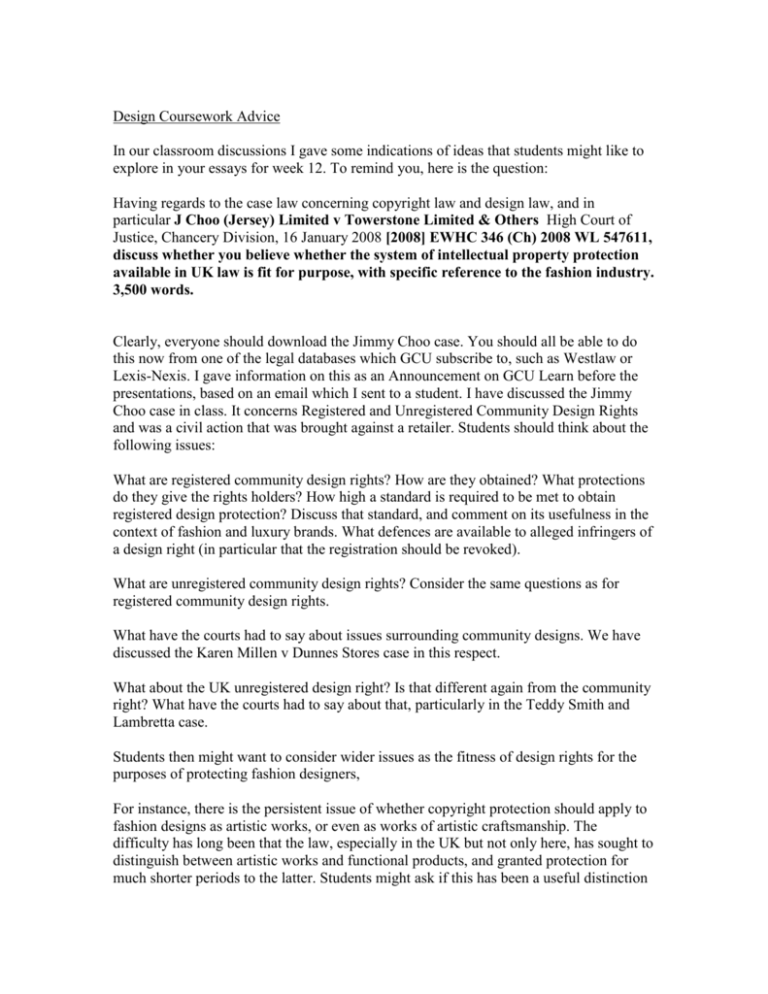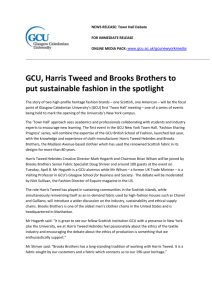Design Coursework
advertisement

Design Coursework Advice In our classroom discussions I gave some indications of ideas that students might like to explore in your essays for week 12. To remind you, here is the question: Having regards to the case law concerning copyright law and design law, and in particular J Choo (Jersey) Limited v Towerstone Limited & Others High Court of Justice, Chancery Division, 16 January 2008 [2008] EWHC 346 (Ch) 2008 WL 547611, discuss whether you believe whether the system of intellectual property protection available in UK law is fit for purpose, with specific reference to the fashion industry. 3,500 words. Clearly, everyone should download the Jimmy Choo case. You should all be able to do this now from one of the legal databases which GCU subscribe to, such as Westlaw or Lexis-Nexis. I gave information on this as an Announcement on GCU Learn before the presentations, based on an email which I sent to a student. I have discussed the Jimmy Choo case in class. It concerns Registered and Unregistered Community Design Rights and was a civil action that was brought against a retailer. Students should think about the following issues: What are registered community design rights? How are they obtained? What protections do they give the rights holders? How high a standard is required to be met to obtain registered design protection? Discuss that standard, and comment on its usefulness in the context of fashion and luxury brands. What defences are available to alleged infringers of a design right (in particular that the registration should be revoked). What are unregistered community design rights? Consider the same questions as for registered community design rights. What have the courts had to say about issues surrounding community designs. We have discussed the Karen Millen v Dunnes Stores case in this respect. What about the UK unregistered design right? Is that different again from the community right? What have the courts had to say about that, particularly in the Teddy Smith and Lambretta case. Students then might want to consider wider issues as the fitness of design rights for the purposes of protecting fashion designers, For instance, there is the persistent issue of whether copyright protection should apply to fashion designs as artistic works, or even as works of artistic craftsmanship. The difficulty has long been that the law, especially in the UK but not only here, has sought to distinguish between artistic works and functional products, and granted protection for much shorter periods to the latter. Students might ask if this has been a useful distinction or not? In particular, it might be worth discussing the interplay of copyright and design rights in the UK. Until October 2014, and the new Intellectual Property Act of this year, it was the law that when a product also incorporated something in which copyright subsisted, then industrial exploitation of the that copyrighted work in a product meant that protection of copyright got reduced to the same period as the protection afforded by design rights. Now s.52 of the Copyright Act has been repealed by the 2014 Act. What are the implications of this for fashion designers, do you think, if any? The IP Act also introduced new criminal offences in relation to copying of registered designs for the first time. Do you think that is wise? Also, consider the defences that might exist for someone charged with the criminal offence of copying a registered design. How important is knowledge of wrong doing, especially if there is a defence that the design right ought never to have been granted in the first place. Students might also wish to consider that if trade mark protection can be extended indefinitely, and that if trade dress can be protected by the law of ‘passing off’ in the UK and in other legal jurisdictions, might that not be sufficient for most fashion businesses to rely on? Also, it might be worth considering the international protection of design rights, beyond the EU, for instance in relation to the US and countries, including China, which have signed up to the TRIPS agreement for the protection of trade related intellectual property rights. Given that this class is an international one, I would very much like to read about your own understanding of design rights in your own parts of the world, by way of comparison with the EU and UK. I have put up a set of set slides from an American fashion course which might be of assistance in this respect, and which supplement my own. Also, there are interesting issues for the fashion industry about whether its very nature as a trend based business, means that protection for design rights is perhaps an unnecessary expense. I would expect students to bring their own original research and insights to the discussion of these issues. It is important to remember that this is an academic essay however, and it is important to respect the genre. Academic essays are supposed to demonstrate research in other academic published works, and to a standard that is higher than a commercial magazine or blog, no matter how instructive and helpful those may be. I have indicated useful journals to look at before, such as Managing Intellectual Property and Journal of Brand Management (both available electronically via GCU Library page). You may find others, beyond the readings which I provided links to from GCU Learn for your reading week. I have also indicated that students should make use of the “Discover” search engine which can be accessed from the GCU Library home page.










